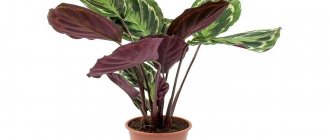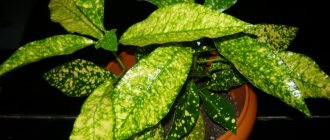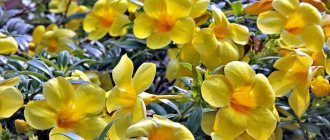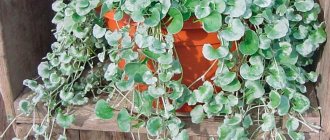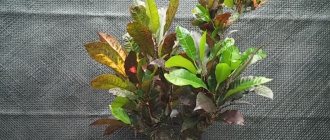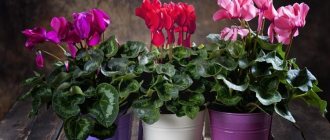Dichondra is often used to decorate the garden - the creeping bush looks great both in flowerpots and on the lawn, replacing ordinary grass. In Russian conditions, the ornamental crop is grown as an annual plant, but with proper care in the spring you can take cuttings, turning it into a perennial.
Soil preparation
Dichondra grows best in deep, loose, well-drained soil, so the seed bed should be troweled or hoeed at least 15 centimeters deep.
If you plan to install a sprinkler system, do it before planting dichondra. Amend the soil with a general purpose lawn food, preferably organic.
Break up the clods, rake the surface and level it to a slight slope so that there are no depressions that will hold water.
Growing
Dichondra is an ideal, unpretentious indoor or balcony plant. It is grown in pots and hanging baskets, from which it hangs in picturesque vines. Loves bright sunlight and will feel and look best on the brightest windowsill. In strong light, the leaves will be larger and more saturated in color. The plant also tolerates partial shade well, but in deep shade it shreds, the leaves will lose their silvery tint and become simply green.
In the gardens of our climate zone it is grown as an annual, but if you bring it into the room in the fall, then this magnificent cascade will decorate the house for many years. Moreover, in the first year of life, Dichondra grows slowly, and more actively gains vegetative mass from the second year, gradually becoming more and more beautiful. You will even have to fight with the wild growth of Dichondra and cut off unruly strands in the fall and spring. After pruning, it will branch more strongly and become more bushy. Cuttings take root well. Layers pressed to the ground take root even better.
The plant is not very demanding on the quality of the soil, but, of course, it will grow better in more nutritious soil. A large volume of vegetative mass implies frequent feeding. They should be done once a week, alternating mineral fertilizers with organic ones, but if you fertilize the plant less often, nothing bad will happen. It will just grow a little slower and the leaves will be a little smaller.
Landing conditions
Dichondra seeds need warm soil temperatures to germinate. It should be planted when the temperature is above 20 degrees.
Typically in most regions this is late spring or early summer. When soil temperatures are too cold, seed germination and lawn establishment are much slower and more maintenance is required.
Dichondra in landscape design and as a hanging plant for decorating facades
Dichondra in an ampel composition with other flowers photo
Growing dichondra in landscape design and indoor floriculture is mainly used for vertical decoration of exteriors and interiors. It is planted in hanging baskets and flowerpots with the ability to grow and cascade into waterfalls of picturesque shoots. It is often used for background landscaping, incomparably shading colorful compositions with its foliage. They even create original sculptures from it. A frame is made from wire, and the dichondra braids it, resulting in an incomparable creation.
Among all the hanging plants, the beautiful dichondra is the most unusual and attractive. Cascades of emerald or silver-green densely leafed shoots are shaped like a waterfall, which is reflected in the name. Dichondra is widely used in the design of gazebos, terraces, and balconies, but it looks most impressive in separate groups in hanging flowerpots. The plant propagates better by layering and cuttings, but if desired, it is not difficult to grow it from seeds.
Dichondra flowers
Sowing seeds
When growing from seeds, you should scatter or sow at the rate of 450 grams per 46–92 square meters. meters. A higher concentration will give the rack density.
Rake the seeds to lightly cover them. A very shallow covering of peat moss or similar organic matter will help retain moisture until your seeds germinate.
Video review
Watch a short video about sowing dichondra:
I grew ampelous dichondra from seeds, just started to grow - autumn came, I couldn’t leave it outside, I brought it home, it seems to continue to grow. What's next? It says on the package that it is a perennial.
Dear Tatyana! My opinion about dichondra in winter is this. You can organize its wintering as a ground cover plant. I specifically ran and took a photo of mine.
This is my box with rosemary and marjoram; later a begonia with purple leaves was planted for decoration. I thinned and rejuvenated the marjoram in the summer. And in the second year, especially the summer on the balcony, dichondra has woven the entire surface of the box so that I can only get it out in pieces, like a pie, tearing off the edges. And marjoram, as you can see, is now suffering: it has nowhere to grow, so this beauty will urgently need to be “infringed” on the rights to the box with my herbs in the kitchen! I would like to note that as a ground cover plant it is quite pretty, and can also hang along the edge like a hanging plant. You can try placing one twig on the soil and lightly digging, pressing, and moistening. And try placing the remaining parts of the plant, on the advice of dear Lyudmila, on the loggia and in the basement. This way you will find the most optimal wintering regime for the plant. About my wintering of dichondra, it should be said that it takes place in the regime of 20-25 degrees and above, sometimes the plant is in a draft (ventilation in the kitchen), but in bright diffused light, the soil is moistened 2 times a week, the soil itself is loose and nutritious, moderately moisture-intensive, I don’t fertilize from November until about mid-February, the rest of the time I water it with fertilizer only while I’m not picking the greens for salads. I would also like to share my experience with the silver dichondra, since it was she who did not want to spend the winter in this mode. I explain this to myself by the plant’s greater demands on lighting. But I still don’t give up hope that with her I’ll get a “rug” like this in a box, because she’s even more beautiful. Dichondras (green and silver) also germinated differently for me: the germination rate of the green one was higher, the silver one was capricious, and this year, after overwintering with problems in the room, it died in a hanging pot on the balcony. But the green one survived the heat, it was underfilled in the box.
Watering
When growing dichondra, the seed bed should be moist but not soggy. The seed sprouts will die as soon as they dry out, so it usually takes several waterings 3-5 times a day to keep the soil moist.
Use a mist to avoid washing away soil and seeds. Proper watering is the most difficult and important step when growing any type of lawn.
In warm weather, the seeds will germinate in 1-2 weeks. The first leaves that appear will be long and narrow and will not look like true dichondra leaves. A week after most of the seedlings have grown, allow the soil surface to partially dry out between sprays.
Gradually increase the amount of watering each time you water, gradually decreasing the frequency. When you water, you need to water deeply, but not often - give dichondra flowers a good soak because they have a deep root system.
Watering too frequently will cause an invasion of diseases and weeds.
Wintering
In our country, dichondra is grown as an annual plant, since it does not tolerate frost very well. However, if it is possible to transport it to a room where above-zero temperatures will be maintained, then “Emerald Falls” can live for several years. The plant is brought into the house around mid-October, before the onset of night frosts. At the same time, overly long branches are cut off, the ground is watered and the pot is placed in an elevated place.
If the dichondra is placed in a heated room, then after turning on the batteries, it should be sprayed daily.
The plant can be placed in the basement for wintering. In this case, before digging, the shoots are cut off, and the root with clods of earth is placed in the cellar. To prevent the rhizome from drying out, it is sprinkled with wet peat and a thick layer of sand. In spring, new shoots with root shoots will form on the stem. They are carefully removed and planted in the ground or in a hanging basket, and it is necessary to fertilize them. The shoots begin to branch much faster and after a month they form a beautiful crown.
In regions with a subtropical climate, the plant can be left to winter outside. To do this, the dichondra is insulated: the root is sprinkled with earth, covered with film, and fallen leaves are sprinkled on top.
Care
Planting dichondra and caring for it in open ground requires attention. But the reward is worth it. A properly maintained Dichondra lawn will require less work in the long run.
By following the steps below, you will have a healthy Dichondra lawn that is free of weeds and resistant to disease and pests.
Possible problems
Regardless of what type of flower is grown - Dichondra Silver Falls or Emerald Falls, the grower may encounter a problem that the leaf begins to shrink and curl. This can happen as a result of insufficient watering.
In addition, many novice gardeners are concerned about the question of why dichondra begins to lose color. This is especially true for the Silver falls variety. This happens mainly due to the lack of lighting, to which the silver dichondra reacts very strongly. Bright lighting and proper care will help maintain the attractiveness and richness of greenery.
Note! The plant is highly resistant to various diseases and pests. The flower copes excellently with all misfortunes, since it is a weed by nature.
Fertilizer
Do not fertilize when Dichondra leaves are wet, and be sure to hose off the leaves when fertilizing. Washing thoroughly after fertilizing will introduce plant food into the soil.
Fertilizing during the fall and winter months is also recommended. Feed your Dichondra lawn monthly with 225 to 455 grams of actual nitrogen. This nitrogen does not have to be chemical in nature.
Good pet compost or homemade compost will contain plenty of nitrogen, as well as traces of other elements needed to grow dichondra. It is preferable to use organic manure compost.
Silver waterfall on a summer cottage
Silver Falls is one of the varieties bred from the wild Dichondra silver. A distinctive feature is the many small leaves located on thin long stems, which are pale green in color with a silver tint.
When grown in a flowerpot or flowerpot, on a retaining wall, or in a balcony flower garden, dichondra behaves like an ampelous plant. Many hanging stems with silvery leaves correspond to the name of the variety, creating picturesque cascades. Due to the inability of the vine to climb a support, it can be planted in compositions with upright flowers.
Designers also appreciated dichondra as a ground cover plant. Where it is planted on the soil, it manages to form an extensive clump over the summer. The low stature of the plant allows you to create spectacular plantings on alpine hills and rockeries, planting ornamental shrubs and arranging tree groups.
Due to its growth and coloring characteristics, dichondra can be used to create borders: it is easy to cut and shape. To design a dry stream or imitate water in landscape compositions, it is difficult to find a replacement for dichondra, since the structure of the vine creates the effect of many streams and flickering splashes.
Silver waterfall at the entrance to the house
When designing compositions, the Silver Falls variety can be combined with Emerald Falls dichondra (growing from seeds of both varieties is not difficult). The combination of metallic silver and green colors can elevate even the simplest flowerpot. Decorative foliage plants will emphasize the beauty of large-flowered plants (roses, dahlias, petunias or begonias, etc.), and will hide the container and bare areas of soil.
Watering rooted dichondra
A common mistake is to water too little and too often. This causes shallow rooting, which weakens the plant and makes it more susceptible to weed invasion and disease.
Apply at least 2 cm of water during each individual watering (taking into account soil drainage issues). Also, do not allow the soil to dry out completely between waterings.
Description of the plant
The unpretentious liana was discovered for the first time in East Asia. This significant event took place more than two centuries ago. The first meeting of botanists with a plant growing in natural conditions did not produce any effect on people. The plant was not appreciated, but this did not last long. After a certain period of time, people finally paid attention to this plant.
Dichondra Silver Falls
Appearance and features
The herbaceous plant dichondra can be either an annual or a perennial. This depends primarily on the growing conditions.
The plant's stems are graceful with shallow roots. They grow up to one and a half meters in length. As a result, they fall down beautifully. The branches are almost completely covered with small leaves that have a rounded shape.
Dichondra blooms from May to August. During this period of time, modest small flowers appear on the plant. They are almost invisible, as they are lost in the dense foliage, which flows beautifully down. That is why the plant is often used for planting in hanging containers, such as flowerpots.
For your information! All dichondras are of subtropical origin and are representatives of the Sinyukhov order.
Creating compositions using dichondra
Trimming
One of the many benefits of dichondra is that it requires less frequent mowing than lawn grass. However, it will look neater if mowed at least once every two weeks, and this will also help control weeds.
Set the mower to a height of 3 to 5 cm during the summer months. Low cutting at low temperatures promotes the formation of a dense, small-leaved cover.
How does it reproduce
Dichondra can be grown in two ways - cuttings and seeds. The simplest method is cuttings, but it is used relatively rarely. According to the nature of its growth and main characteristics, the flower is a ground cover, so it can grow both in open ground and at home. The exception is Siberia, where the plant can only be grown at home.
Ampelous dichondra does not grow outdoors in Siberia
Ampelous dichondra can reproduce both by seeds and cuttings. The first method requires a lot of effort and patience, despite the fact that it is used relatively more often. This is explained by the fact that the plant is not very common among gardeners, so it is much easier to purchase seeds.
Propagation by seeds
It is best to plant seeds in pots in January or February. In this case, by the beginning of the summer season it will be possible to decorate the garden or balcony with the plant. Flower growers recommend preparing the soil for sowing in advance, into which the seeds should subsequently be sown to a depth of about 5 mm. After this, you need to sprinkle them with soil, water them thoroughly and wrap them with film. Such measures will help prevent moisture evaporation. The container with seeds must be placed in a warm place where the air temperature is at least 25 °C.
As soon as two main leaves appear on the sprouted shoots, they will need to be transplanted into separate pots, the diameter of which should not exceed 10 cm. Plants are transplanted into open ground after 8-9 weeks from the moment the shoots are planted in separate pots. It should be taken into account that planting should be carried out in heated soil.
In addition, when growing a flower from seeds, the following nuances should be taken into account:
Before planting in open ground, seedlings should be hardened off. Currently, flower growers who choose ampelous dichondra for planting give greater preference to growing from seeds.
Propagation by cuttings
Stem layering is best suited for propagation by cuttings, since it is they that take root most easily if optimal conditions are created for them. The cuttings must be placed in a warm place, the air temperature should vary from 22 °C to 24 °C. As soon as roots appear on the cuttings, the shoot can be divided and then pressed in several places to the moistened soil.
Weed, disease and insect control
The first line of defense is a neatly maintained lawn, created through proper fertilization, mowing and watering. With proper care, there will be no weeds on the dichondra, as it will grow into a dense mat with no room left for weeds.
A healthy Dichondra lawn, planted in the right conditions and properly maintained, will in most cases be free of weeds, diseases and pests.
Warning! Do not use broadleaf herbicides on dichondra as they will kill your lawn.
Dichondra can become susceptible to pests such as flea beetles, cutworms and weevils when stressed due to improper care or adverse weather conditions.
There are insecticides on the market to kill these pests, but prevention through proper care is the best line of defense. After all, you chose a lawn alternative for a reason, usually to avoid the use of chemical products.
Organic pest control methods you may encounter include homemade "pesticides" such as garlic/onion sprays, dish soap, cayenne pepper.
Transfer
Dichondra silver waterfall growing at home photo
The flower is often grown as a houseplant. Caring for this beauty is simple: timely, regular watering (without excess) and sufficient lighting. The air temperature in the room is quite comfortable for the plant; you should not allow it to drop below 10 °C. There are no special requirements for air humidity. The plant responds well to feeding in the spring and summer with a frequency of 1-2 times a month.
It perfectly tolerates proximity to other flowers, which is used to create spectacular compositions. Dichondra is usually planted along the edge of a voluminous pot, creating a cascading waterfall of leaves that shades decorative flowering plants.
Over time, the space for the dichondra becomes small, and it becomes necessary to transplant it into a larger container. If necessary, the flower is replanted using the transshipment method - when the roots tightly entwine the earthen lump in the pot. The signal for this operation is the appearance of roots from the drainage holes of the flowerpot. To do this, select a larger container, on the bottom of which expanded clay is placed, sprinkling it with a small layer of soil on top.
Roots that protrude from the drainage holes are trimmed. With one hand, take the top of the pot and turn it over so that the container is at the top. With the other hand, the flowerpot is removed from the plant like a hat from the head. Then they carefully turn the roots into a new container, pouring fresh soil into the space between the walls of the pot and the roots.
If it is not possible to keep adult plants in an apartment, then many gardeners grow dichondra as an annual, so in the fall they take cuttings, rooting the vines, thereby rejuvenating the flower. Such plantings take up very little space and are much easier to care for.
Dichondra bushes do not lose their attractiveness for 6 years or more with proper, timely care. In Australia and New Zealand, the plant is considered a malicious weed, mercilessly exterminated by farmers and gardeners, but Europeans recognized dichondra as one of the best plants for decorating vertical compositions.
You need to replant the plant to a permanent place in the evening. During the night, the root system adapts to new conditions, which will increase the survival rate of the bush.
Before planting, you need to form holes at a distance of 10 cm from each other. A peat mixture is placed at the bottom of each hole. And only after this, with care, so as not to damage the delicate roots, is the bush planted. The hole is filled with earth and watered well with warm, settled water.
Planting dichondra seedlings
Often grown as an annual. In southern countries and in its historical homeland it grows for several years and is a perennial. In Australia it is considered an ornamental weed with a sanitary role. Usually dichondra is planted in hanging containers.
A green or silver waterfall forms quite easily. Subsequently, you only need to monitor the shape of the “beard” by trimming it regularly. The Silver variety plant is found in independent plantings, as well as in compositions with other flowers.
Shaping a Waterfall Beard
The Repens variety is often used to form green cover on an area. Moreover, if the garden soil has differences in height, then this is beneficial. In this case, the dichondra carpet looks more impressive. The liana looks beautiful in flower beds with helichrysum and when decorating the balconies of houses in combination with flowering plants.
We invite you to familiarize yourself with Currant Viksne: variety characteristics and care

